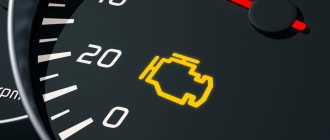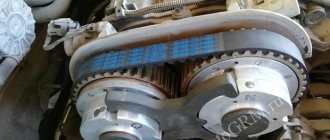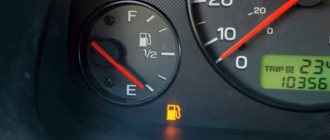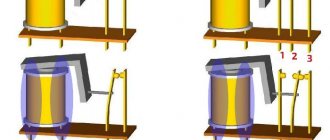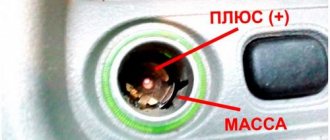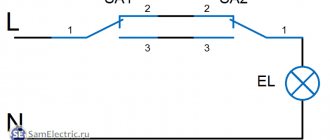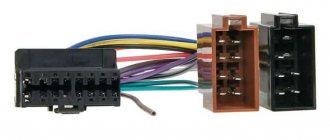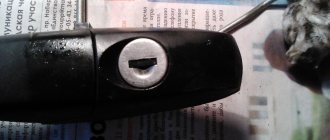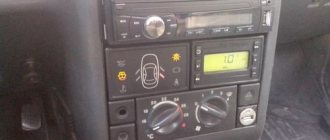The translation of the expression “check engine” in Russian literally sounds like “check the engine.” The “check” icon is on the dashboard of most modern cars, but its meaning remains unclear to many. Therefore, if this icon - a yellow or orange engine icon - appears and does not disappear (or simply blinks), a logical question arises in an inexperienced driver: “what does this mean?” Next, we’ll try to find out the reasons why the check engine light came on on the dashboard of your car, as well as how to get rid of it.
Initially, this light indicated problems with the carburetor, but now that cars are equipped with full-fledged on-board computers, the message may indicate various malfunctions. For example, a “check engine” error may indicate problems with the quality of the air-fuel mixture or ignition faults, as well as many other things. Messages can be caused by both minor and critical failures.
Thus, when the “check engine” light is on, it is only clear that the ECU has detected a malfunction in one of the car’s systems. Only diagnostics can give a complete picture. Next, we will look at the main reasons why the check engine light is on and what needs to be done about it.
TOP 10 reasons why the check engine light came on
- The fuel tank cap is open . Check if it is closed tightly.
- Bad gasoline . The system can respond to fuel quality. The solution would be to drain the gasoline and fill it with better quality.
- Oil level . First of all, check its level with a dipstick. Also look for cracks in the block and oil leaks.
- Problems with the fuel pump or strainer in the tank. Check that the pump runs smoothly and does not make any unusual sounds.
- Dirty injectors . Eliminated by cleaning the injectors.
- Faulty high voltage wires or coils.
- Problem with spark plugs . The icon also lights up if there are problems with the spark plugs. It is worth checking the performance of the spark plugs and, if necessary, replacing them.
- No spark in one of the cylinders.
- The lambda probe is faulty . The problem can only be eliminated by replacing this unit with a new one or installing a blende; occasionally cleaning helps.
- Catalyst failure . Also solved by replacing the catalyst.
Only the main reasons and ways to solve them are listed here. In fact, there are many more of them. Diagnostics of the on-board computer, which controls all vehicle systems, can give a more complete picture of the current situation.
Check engine is not hidden on the dashboard of the Madza CX-5
Check engine on the Peugeot Partner panel is hiding in the left corner
Let's sum it up
As you can see, in some situations the check light comes on and the engine starts. This may indicate that the ECU allows the unit to start, but the engine will operate in emergency mode or the problem is not critical. In other situations, the check light comes on and the engine stalls. In this case, the malfunction may be related to the fuel supply, failure of the crankshaft position sensor (CPS), etc.
Over the past decades, scientific and technological progress has advanced so far that even budget cars are equipped with on-board computers. More precisely, these are not computers, but ECM. The system includes warning lights that light up on the vehicle's dashboard when a malfunction occurs in the engine or one of the systems.
However, it also happens that after starting the engine the “check” lights up. Also, the engine malfunction indicator can light up while driving, the check light comes on and goes out in different operating modes, cold, hot, etc.
How to remove check engine
Let's take a closer look at the steps that need to be taken first of all in order to get rid of the Check Engine indicator that lights up. The priority action algorithm will be as follows:
- Check if the gas tank cap is closed . The situation is especially relevant if you have just left the gas station, and soon after that the check engine icon comes on. This means that either the tightness of the fuel system has been broken due to the tank cap not being screwed tightly enough, or the quality of the fuel leaves much to be desired.
- Check the condition of the spark plugs . To do this, unscrew them and visually assess their condition. Very often, it is the spark plugs that cause the Check Engine light to come on. In particular, the reason may be that they begin to pass current due to carbon deposits on the electrodes. This coating is formed as a result of the high content of metals or other conductive substances in the fuel. An error may also occur if the gap between the electrodes on the spark plug exceeds a distance of 1.3 mm. We will look separately at diagnosing candles and how to do it based on their color. You will also find information about replacing them useful.
- Oil level. If the check engine light only lights up when the engine warms up, stop and listen, you may hear extraneous sounds from the engine. Check the engine oil level with a dipstick and add it if necessary. Also check for oil leaks.
- If your car is equipped with sensors for the purity of process fluids (motor oil, fuel, etc.), then the indicator may light up if the corresponding indicators exceed the permissible limit . The solution is to replace the appropriate filters or completely liquids if they do not meet the standards.
- Resetting the negative terminal from the battery ( 15...20 seconds ). After this, the Check Engine light should go out and the clock on the computer should reset to zero. This method may be relevant in two cases. The first is a banal “glitch” of the ECU. The second is if a large number of small errors have accumulated in the memory of the electronic unit and have not been reset. (usually they are caused by the use of low-quality gasoline, the presence of harmful impurities in the fuel-air mixture, moisture on electrical contacts, etc.).
The most convenient way is not to reset the terminal, as all settings in the car are reset, but to use a multi-brand scanner, such as Rokodil ScanX
.
After all, this is an inexpensive option that is compatible with 99% of cars manufactured in 1993, and it also fully supports all the functionality of popular diagnostic programs for smartphones. Whatever block there is an error in, you will not only reset it, but also see approximately the reason for the occurrence. If, after performing the above steps, the Check Engine indicator does not go out, or goes out, but soon lights up again, this means that the error lies deeper, and in order to eliminate it, additional detailed diagnostics must be carried out using more serious means.
Engine malfunction indicator: main causes of fire. Methods of their treatment
There are quite a few reasons why the engine diagnostic light comes on, since the signal comes from the on-board computer, which simultaneously analyzes many vehicle operating systems: ignition, automatic transmission, engine, carburetor, etc. Some faults can be diagnosed independently, but first, let's figure it out in their reasons:
- If the engine light comes on, you need to start by checking the tightness of the fuel system, for example, the gas tank cap is not tightly tightened or it has defects. This engine warning light often comes on for this very reason.
- If the “Check” engine malfunction indicator lights up while the car is moving, this may be a signal of low engine oil level. To diagnose this malfunction, it is recommended to stop and listen to the engine in order to identify the presence of extraneous knocks and noises. And also carry out a visual inspection of it - check the oil level, inspect for leaks and damage to the body.
- In the conditions of our country, the quality of fuel and lubricants products wants to be the best, as a result of which the engine malfunction icon may also light up. To be treated by simply replacing bad fuel.
- If, despite stable and smooth engine operation, the check engine light still comes on, this may be a sign of a misfire in one of the spark plugs. If you find a “piercing” spark plug or armored wire, then they must be urgently replaced, since they are the main igniters of the fuel system. With a faulty spark plug, you may feel slight jolts when accelerating, which is caused by improper spark supply. The recommended replacement interval for spark plugs is 25 - 30 thousand km. Please note that timely replacement of spark plugs not only improves engine performance, but also reduces fuel consumption. By the way, the gap between the spark plug electrode should not exceed 1.3 mm.
- Ignition coil malfunction. It is necessary to check for the presence of a spark and resistance at the coil terminals.
- Malfunction of the oxygen sensor (lambda probe). This sensor helps monitor your vehicle's fuel consumption, so if it malfunctions, it can have a significant impact on how much power you get and how much power your engine makes. The cause of the breakdown is oil soot, which covers the sensor with a thin layer, which reduces the performance of the gasoline mixture adjustment sensor. In addition, untimely replacement of the sensor can lead to failure of the catalyst. Treated by replacing the sensor.
- Malfunction of the exhaust gas catalyst. The catalyst not only provides more environmentally friendly exhaust gases, but is also responsible for the dynamics of the car. The main cause of catalyst failure is untimely replacement of the oxygen sensor and spark plugs, since the conversion of carbon monoxide in the catalyst into harmless chemical elements depends on them. Otherwise, the catalyst will overheat and may burst. Treat with replacement.
- The injectors are not working properly. As a rule, they require cleaning, but sometimes even replacement.
- Malfunction of the mass air flow sensor.
This sensor is responsible for the leanness of the supplied mixture. A malfunction of this sensor can lead to increased fuel consumption, a decrease in engine power and disruption of the smoothness and dynamics of the vehicle. In addition, the car may have difficulty starting or idling smoothly.
The main reason for sensor failure is untimely or incorrect installation of the air filter.
Please note that if the mass air flow sensor is broken, you can drive for quite a long time, but this will negatively affect, first of all, fuel consumption. Treat with replacement.
- Faulty fuel pump or fuel filter. It is necessary to measure the pressure in the ramp (its value should not be less than three atm.). Treat by cleaning the filter and mesh in the gas tank. More drastic measures are replacing the fuel filter or fuel pump.
If the above “treatment” methods did not help and the check light still lights up on the instrument panel, then you must immediately contact a car mechanic, otherwise this may result in serious repairs.
Owners of cars with an electronic engine control system (ECM) quite often encounter the unexpected illumination of the “check engine” warning light on the dashboard. Let us immediately note that if the engine check light is on, then this indicates certain malfunctions that are associated with the operation of the power unit and its systems.
There can be quite a few situations when the engine fault check light comes on. Owners often complain that after washing the engine the check light comes on, the check light comes on when the engine is running, or the internal combustion engine does not start, the warning light periodically or constantly lights up on a cold or hot engine, etc. Next, we will look at the main reasons why the check engine light may come on, and also talk about ways to diagnose and fix a number of common faults with your own hands.
Read in this article
The check engine light is on - what should I do next?
You can try to find out the reason yourself by counting the number of blinks of the “check” and check the technical documentation for the designation of such an error code. For different cars there are different intervals between flashes and different codes by which they are interpreted.
Most of the errors that the indicator tells you about are not critical . You can perform diagnostics in two ways - yourself and by visiting a service station. The fact is that to obtain information in this case, you need special equipment or at least software for a smartphone.
But first of all, you need to find out how the car’s behavior changed after the error appeared. This is done in order to determine whether it is possible to drive with the check engine light on the panel, or whether it is better not to do this so as not to aggravate the problem.
| Car behavior | Icon is lit continuously | The check is blinking |
| No changes in car behavior | Movement Can continue | NOT continue driving |
The car suddenly changed its behavior:
| IT IS FORBIDDEN keep moving | IT IS FORBIDDEN keep moving |
| Engine power and throttle response remain the same | Can keep moving | Can keep moving |
| The engine has become less responsive, the speed does not rise above a certain value (engine operation in emergency mode) | You can continue moving | The movement cannot be continued |
| No additional warning lights came on on the instrument panel. | Can drive | You can go |
Along with the check engine icon, another indicator came on:
| Movement IT IS FORBIDDEN continue | Movement IT IS FORBIDDEN continue |
When does the check engine light come on?
We find out the reason why the check light is on
The error code can be read using a laptop with special software. The computer is connected via a cable to the machine's ECU and diagnostics are carried out. Also, using a laptop, you can enter additional external commands into the control unit or correct (reset) errors that appear.
A simpler method is to download an ECU communication and analytics program to your Android smartphone (for example, TORQUE, it has free and paid versions). And a Bluetooth adapter (car scanner) is connected to the electronic unit, which allows you to read information from the device. If you don’t have a laptop or you simply don’t want to bother installing additional software, you can delegate the described procedures to service station workers. They have all the necessary equipment and programs.
It must be remembered that each car (and sometimes each ECU on the same cars, but different years of manufacture) has a different list of error codes . Therefore, after receiving the information, you must have a standard set of diagnostic error codes (Diagnostic Trouble Code - DTC). You can find it in additional literature on diagnostics or on the Internet (for example, on thematic forums dedicated to your car model).
Another common cause for injection engines is problems with the injectors. In particular, the appearance of a significant amount of sediment on them. The solution to this problem is to clean the injectors. If problems occur with spark plugs, injectors, or the activated check engine indicator, the following symptoms may occur:
- weak engine thrust;
- high fuel consumption;
- jerks when accelerating or unstable operation of the engine;
- “floating” engine speed at idle.
The next step is to check the pressure in the fuel system. To do this you need to use a pressure gauge. The standard pressure for most non-tuned cars is 3 atmospheres (kgf/cm2). However, check this information in the registration certificate of your car. If the pressure is significantly lower, then the problem may lie in a faulty fuel pump or dirty injectors. If the pressure is constantly low, check the fuel pump. If at first it is normal, but drops shortly after starting the engine, check the injectors. Also pay attention to the mesh in the gas tank.
It is also worth checking the insulation of high voltage wires . It is better to do this not visually, but using a tester turned on in ohmmeter mode. wire insulation value at least 0.5 MOhm . Otherwise, the wire must be replaced.
If the Check Engine light comes on after you turn the key, and then goes off a few seconds later, this means that the system is performing a self-diagnosis and there is no cause for concern.
How to get to the service station when the Check Engine light is on
When driving to a service station, try to maintain a gentle driving regime. In particular:
- do not exceed speed more than 60 km/h;
- do not exceed engine speed more than 2500 rpm;
- turn off the air conditioner (heater), multimedia system and other currently unnecessary equipment that creates additional load on the engine;
- Avoid sudden starts and braking, drive smoothly.
You can return to normal driving only after diagnosing and eliminating the identified errors.

